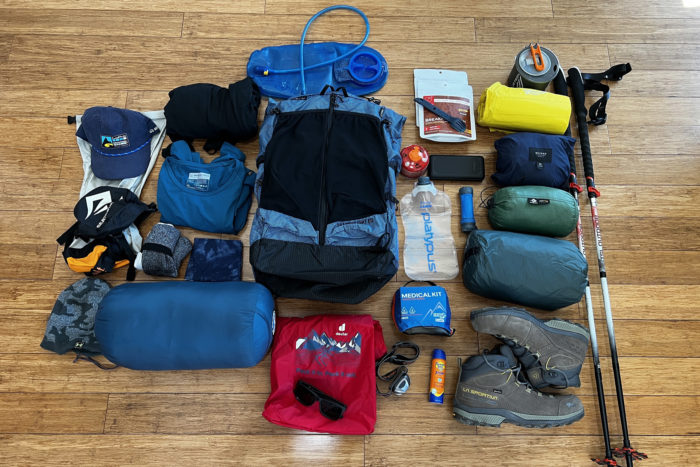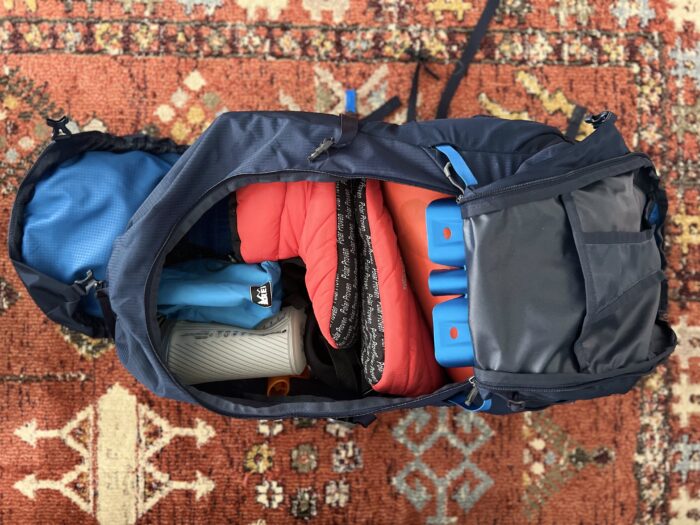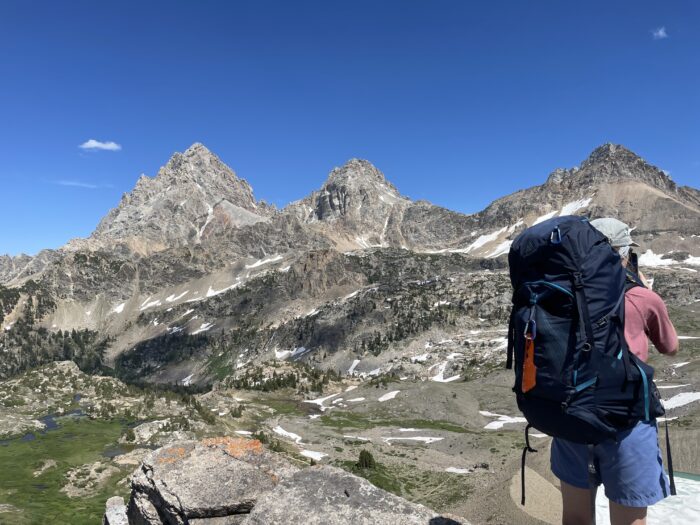You and your filled-to-the-brim backpack are standing tall at the beginning of the trail, ready for the strenuous, long, and beautiful hike ahead. At first, your thirst for adventure keeps you afloat. Then, real thirst strikes. You reach to grab your water bottle only to realize it’s at the bottom of your pack. So you step off to the side of the trail and unzip your backpack.
Next thing you know, your gear is all over the place as you dig through your pack searching for your water bottle. Eventually, you find it and quench your thirst. But now, you have no idea how you’re going to fit all your belongings back into your backpack.
If you’re headed out on a multinight backpacking trip and your current mentality is to just “throw everything in the pack and hope it fits,” well, we’re here to give you a friendly and much-needed reality check. It’s wildly important to know how to properly pack a backpack. And, trust us, because we know from experience how much of an inconvenience, and downright liability, a haphazardly packed backpack can be.
Knowing how to properly and efficiently pack for overnight trips will save you time and frustration. It’s important to know what to bring and how to pack it. With these steps and tips, you’ll have your own back on your next outdoor adventure.
How to Pack a Backpack

1. Acquire a suitable backpack. Before you consider anything else, the most important thing is to get a backpack that fits you. You want one that has the right capacity for your gear as well as other features tailored to how you will use the pack.
For more in-depth info, here’s our buyer’s guide to the best backpacking backpacks of 2023. You can also check out our video outlining the key features of the Jack Wolfskin Highland Trail XT 60L Pack. It highlights features you should look for in any pack regardless of which brand you purchase.
Also, take note if the pack is marketed as gender-specific and whether it’s designed for backpacking or for other activities.
2. Gather all other necessary gear, which varies depending on your specific backpacking trip. Check out our favorite backpacks, sleeping bags, sleeping pads, and tents for backpacking. We also have a checklist for basic backpacking gear.
Beyond that, you might want to bring a fishing pole if you’re going to a lake, crampons if you’re going to be crossing snow, or a swimsuit if you’re passing by natural hot springs. Consider the adventure ahead of you and pack accordingly. But optimize space and keep it as light as possible — stick to the essentials, and thank yourself later.
Once you gather your gear, lay it all out and make sure you have everything before loading it all in the pack. It may serve you well to put items in separate pouches or bags within the backpack to keep things separated and grouped.
3. Pack the bottom of the pack first. How you pack your gear isn’t a one-size-fits-all method. Some people are meticulous and perfectionist. Others stuff until they can’t stuff anymore. Packing techniques also differ depending on the design of the bag and what you’re packing. But there are some general rules that benefit every style of packer.
Pack your sleeping bag at or near the bottom of your pack. You won’t need it until you arrive at your camping spot, anyway. Then, do your best to put heavy items low and closer to your back.
4. Pack the middle of the pack. The middle is where the bulk of your backpacking gear should go. For example, this could include a sleeping pad, tent, extra clothes, food, etc. Just continue to follow the rule: Heavier stuff goes lower and closer to the back and sides, and lighter stuff can go up higher. At the very top, keep things you might need on the trail, like a rain jacket or water filter.
This weight distribution helps reduce pull on the shoulders, which can get sore while backpacking. If you bring a bear canister, that should go toward the bottom/middle region of your pack because of its size. Be sure to fill it with food and other supplies before putting it in the pack to optimize space.
5. Pack the brain of the pack. The compartment on top of the pack is called the brain. It’s great for smaller, frequently used loose items like sunscreen, lip balm, sunglasses, cellphones, lighters, a deck of cards, a small pair of binoculars, maps, snacks, headlamps, toilet paper, menstrual items, or a journal and pens for field notes.

6. Pack water and the outside of the pack. On most hiking packs, there are typically pockets on the side and a pouch inside specifically designed for water bottles and hydration reservoirs. Make sure you’re loaded with water before hitting the trail. Pro tip: Add ice to your water or reservoir at home. On a hot trail, you’ll thank yourself later for the cool refreshment.
7. Pack the outside of the pack. If you have any gear that needs to go on the outside of the pack like ice axes, trekking poles, a tent, a cooking pot, or anything else, use daisy chains, lashing points, and straps to cinch them tightly to the outside. If you have a climbing rope, you can drape it over the top of the main compartment and close the brain over it, securing it in place.
Finally, pull on the compression straps on the outside of the pack to compress it.
8. Try it on. Now that everything’s full and packed, it’s time to test out how the pack feels on your back, its new home for the next few days! Be sure you’re well-balanced before lifting the pack, using your core body strength so as not to strain any muscles.
9. Buckle up the pack, making necessary adjustments. First, clip and tighten the waist belt. Typically, this strap rests on the middle of the hip bones to take most of the weight off the shoulders.
Next, adjust the shoulder straps, sternum strap, and load-bearing straps to find a comfortable fit. Of course, some personal preferences are involved when making adjustments, but the main thing to focus on is the weight distribution. If you feel that the pack is top- or bottom-heavy, or if too much weight is on the outside of the pack, pulling you backward, you may need to adjust your packing.
When your pack is fully adjusted and on your back, it should comfortably rest on your hips and hug your upper body.
10. Head for the hills! You’ve already made the initial adjustments before beginning your journey, but you’ll have to make smaller adjustments throughout your hike. Items may move throughout the day, and your body will get sore.
With that, take time to make sure your pack still feels well-balanced as you’re moving. If you use these steps to pack your bag effectively, that should be no problem at all.

How to Pack a Backpack: FAQ
What are the important features to consider when purchasing an overnight backpack?
When you’re shopping for a backpacking pack, there are a few factors you should keep in mind (not necessarily in this order):
- Weight of the pack
- Volume (usually measured in liters)
- Materials
- Price
- Design
- Comfort
What are the best backpacking backpacks?
As we’ve mentioned, the best backpacking backpack is whichever one fits you best and has the necessary features for your overnight adventure. Different backpackers gravitate toward different brands and styles. Some people like ultralight minimalist packs while others are bigger fans of heavier, stiffer, external-frame packs.
If you’re looking for a place to start, Gregory, sold by REI, makes excellent packs our testers found extremely comfortable. Gregory offers packs designed specifically for men and women. Ideally, if you’re in the market for a pack, you should head to your nearest outdoor retailer to get fitted and try a few different packs on.

What are the essentials for an overnight backpacking trip?
At GearJunkie, we’ve created a checklist for backpacking essentials and a breakdown of how to choose the right gear. While a lot depends on the climate, intensity, and other individual factors of your trip, many of the essentials stay the same.
If you’re a backpacking beginner, don’t let the process or the gear intimidate you. The main essentials include:
- Backpack
- Sleeping bag
- Sleeping pad
- Backpacking tent
- Headlamp
- Kitchen gear
- Water bottle/hydration reservoir
- Water filter/purification tablets
- Food
- Bear canister (if needed)
- Clothing
- Shoes
- First-aid kit
- Map, compass, or GPS
How do you pack a backpack for a day hike?
If you’re going for a day hike, there’s no need to lug a huge backpacking pack. Instead, you can use a daypack. These smaller packs are typically around 12-25 L.
How you pack your daypack, of course, depends on many factors that are unique to your trip. Generally, it’s easier and less systematic than packing a multinight pack. But the rules are generally the same: Keep heavier items lower and closer to your back, and keep items you’ll need on-hand toward the top.
Make sure you have plenty of layers packed for potential weather changes. Keep water easily accessible and your essentials bag within reach, usually in a side pocket.
Because of the size difference between a daypack and a large pack, where you put your items does differ slightly. But, similar to packing a large pack, you may want to separate your gear into smaller bags for ease of storage. This will make everything much less hectic in your main backpack compartment.
Final Tips & Tricks
- Use a checklist (and check it twice) so that you don’t forget anything.
- Bring plenty of water, snacks, and food!
- Layer your clothing.
- Tell someone you trust where you’re headed in case anything goes wrong.
- If possible, try on a backpack at an outdoor store before purchasing to be certain it’s a good fit.
- Separate your gear into different bags to make items easier to find.
- Pack a small essentials bag and keep it easily accessible at all times at the top of the pack.
- Make small adjustments throughout the day to maintain the optimal fit for your pack.
- Repack properly after each night of your trip.











